Home | Category: Gods and Mythology / Culture, Literature and Sports
ANCIENT GREEK MYTHS

Atlas and Hercules
Mythology and religion were intertwined in ancient Greek and Roman religion. Many elements and figures in Greek religion and mythology have become important elements and icons in modern European and American culture. The word myth comes from “ mythos” , the Greek word which meant both “truth” and “word.”
Myths were popular in ancient times because they helped explain the complexities of the universe in ways that human beings could understand and also explained things in the past that no one observed directly. Myths appeared in many culture to explain things like why the sun disappeared at night and reappeared in the day; to sort out why natural disasters occur; explain what happens to people when they die; to create a credible story as how the universe and mankind were created. Because so many of things were unexplainable it was simple enough to create gods and say did the did the unexplainable things.
The myths on similar subjects—such as the coming of spring and the presence of gods in the sky — are often remarkably similar in cultures that have and never have had contact with one another. Flood stories after creation, for example are very common. By the same token, the telling of a certain myth can vary in small ways and in large between groups of a certain time period or area within a culture.
The originators of the Greek myths are unknown. The sources of many of the myths are Homer’s epics, the plays by Aeschylus, Sophocles, and Euripides and other writings that have been passed down over the centuries. In some cases the stories were not spelled out but have been inferred from references to them in other stories. The story of creation and other stories comes from “ Theogony” by the Greek poet Hesiod (750-675B.C.), who claims the Muses told him the story while he was tending sheep.
Categories with related articles in this website: Ancient Greek and Roman Religion and Myths (35 articles) factsanddetails.com; Ancient Greek and Roman Philosophy and Science (33articles) factsanddetails.com; Ancient Greek History (48 articles) factsanddetails.com; Ancient Greek Art and Culture (21 articles) factsanddetails.com; Ancient Greek Life, Government and Infrastructure (29 articles) factsanddetails.com; Early Ancient Roman History (34 articles) factsanddetails.com; Later Ancient Roman History (33 articles) factsanddetails.com; Ancient Roman Life (39 articles) factsanddetails.com; Ancient Roman Art and Culture (33 articles) factsanddetails.com; Ancient Roman Government, Military, Infrastructure and Economics (42 articles) factsanddetails.com
Websites on Ancient Greece and Rome:
Internet Ancient History Sourcebook: Greece sourcebooks.fordham.edu ; Internet Ancient History Sourcebook: Hellenistic World sourcebooks.fordham.edu ; BBC Ancient Greeks bbc.co.uk/history/; Canadian Museum of History historymuseum.ca; Perseus Project - Tufts University; perseus.tufts.edu ; ; Gutenberg.org gutenberg.org;
British Museum ancientgreece.co.uk;
Illustrated Greek History, Dr. Janice Siegel, Department of Classics, Hampden–Sydney College, Virginia hsc.edu/drjclassics ;
The Greeks: Crucible of Civilization pbs.org/empires/thegreeks ;
Oxford Classical Art Research Center: The Beazley Archive beazley.ox.ac.uk ;
Ancient-Greek.org ancientgreece.com;
Metropolitan Museum of Art metmuseum.org/about-the-met/curatorial-departments/greek-and-roman-art; The Ancient City of Athens stoa.org/athens;
The Internet Classics Archive kchanson.com ; Internet Ancient History Sourcebook: Rome sourcebooks.fordham.edu ; Internet Ancient History Sourcebook: Late Antiquity sourcebooks.fordham.edu ; Forum Romanum forumromanum.org ;
“Outlines of Roman History” forumromanum.org; “The Private Life of the Romans” forumromanum.org|; BBC Ancient Rome bbc.co.uk/history;
The Roman Empire in the 1st Century pbs.org/empires/romans;
The Internet Classics Archive classics.mit.edu ;
Bryn Mawr Classical Review bmcr.brynmawr.edu;
De Imperatoribus Romanis: An Online Encyclopedia of Roman Emperors roman-emperors.org;
Cambridge Classics External Gateway to Humanities Resources web.archive.org/web;
Ancient Rome resources for students from the Courtenay Middle School Library web.archive.org ;
History of ancient Rome OpenCourseWare from the University of Notre Dame /web.archive.org ;
United Nations of Roma Victrix (UNRV) History unrv.com
Difference Between Myths, Legends, Fables and Folktales
According to the Canadian Museum of History: “People sometimes use the words myth, legend, folktale and fable as though they were interchangeable, but are they? The dictionary definition of each is as follows: 1) Myth: a usually traditional story of ostensibly historical events that serves to unfold part of the world view of a people or explain a practice, belief or natural phenomenon; 2) Legend: a story coming down from the past, especially one regarded as historical although not verifiable; 3) Folktale: a characteristically anonymous, timeless and placeless tale circulated orally among a people; 4) Fable: a narration intended to enforce a useful truth especially one in which animals speak and act like human beings. (Webster’s) [Source: Canadian Museum of History historymuseum.ca |]

Jason and the Argomauts
In reviewing these definitions it is easy to see why, in casual conversations, these terms are used in an inexact fashion. A review of some of the secondary definitions adds to the confusion. A secondary definition of legend reads “a popular myth of recent origin”. Even mythology specialists openly differ on descriptions and definitions of these terms. Finding scholars who agree and disagree on the following observations should not be difficult.
The purpose of a fable is to teach some moral or principle of behavior. Aesop’s fables provide a range of such lessons (e.g. The Hare and the Tortoise = slow and steady wins the race). Fables are clearly fictitious and often contain elements of the supernatural but no mature reader would conclude that long ago these things really happened. But few would argue that fables have both entertained and enlightened children of all ages and cultures for many centuries. | “Folktales also fall into the realm of fiction. They are not based on a particular individual or incident. Animals are often involved and they often act like humans. Legends are very specific and they focus on a particular individual or incident e.g. The Legend of Paul Bunyan or the Legend of Sleepy Hollow. These stories get handed down from generation to generation but lack hard evidence to back them up. And then, there is myth. |
“There have been a lot of academic arguments over the years on what constitutes a myth. Most cultures have them and although the content varies, the characteristics are roughly the same. Firstly, a myth is the story of a people passed down through the generations and not traceable to a particular author. Secondly, there is often a kernel of truth in a myth if you look at it searchingly. Thirdly, there are often variations in the story. (A string of storytellers in different locations over the years tend to add elements that often feature their locale.) Fourthly, “the faithful” believe the myth to be true and an important part of their belief system. Fifthly, a supernatural entity almost always plays a role. Sixthly, the myth offers an answer for phenomena or events in the absence of more plausible explanations, e.g. how mankind came into existence, what causes lighting, the changing of the seasons. Myths also often break the laws of nature- Odysseus visits the Underworld, Achilles can’t be injured except in the heel, everything Midas touches turns into gold. |
Classical Greco-Roman Mythology
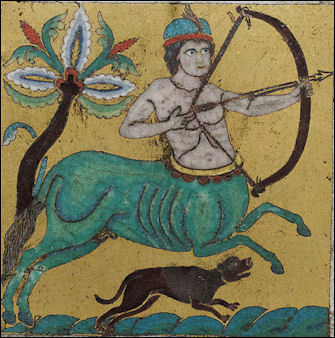
Centaur According to the Canadian Museum of History: “Greek myths, as we know them, came to us from the lips of a small number of gifted and influential poets. The stories which they have passed on to us had been evolving over generations, had been tested in the face of critical audiences and were likely written and revised numerous times until they were in their present form. Carefully examined, they reveal a lot of information about the early Greeks, compelling information to those who are their intellectual, political and artistic heirs. [Source: Canadian Museum of History historymuseum.ca |]
“We owe a debt of thanks, first and foremost, to Homer, the greatest epic poet, followed closely by Hesiod whose Theogony was a “who’s who” guide to the Greek pantheon. Pindar, (some say the greatest lyric poet ever), filled his victory odes with mythological references. The three Greek playwrights of tragedy- Aeschylus, Sophocles and Euripides wrote almost exclusively on mythological subjects (One of them was quick to acknowledge that he and his contemporaries “all dine on crumbs from the great table of Homer”.) Herodotus, Aristophanes, Pausanias and Apollodorus round out the list of the ten men who collectively wove the fabric that essentially is Greek mythology. |
“Classical mythology has become an integral part of our lives although few today believe in the pantheon of gods and goddesses created and sustained by the fertile imagination of the ancient Greeks. Wander into any art gallery or museum and you will see evidence of the influence of mythology on the choice of subjects. Greek painters and sculptors went to the vast warehouse of mythology to draw inspiration for countless thousands of works; now we draw inspiration from their masterpieces. Greek playwrights relied on the tragedies of mythology to entertain audiences of their generation and subsequent ones up to the present day. |
“Hollywood movies, comic books, television programs and various genres of literature have peopled their stories with characters from mythology or derivatives from them. The world of advertising has also borrowed freely from mythology using the names and attributes of gods and goddesses to sell their products and services. Look at the telephone directory to see Atlas, a symbol of strength, used to sell steel and tires; Apollo, for a music store; Aphrodite, spa and beauty services; Athena, intellectual property; Hermes, messenger services; Dionysus, wine-making supplies. The world of classical mythology lives on in the 21 st century.”
Greco-Roman Mythology, Their Gods, Science and the Unknown

According to the Canadian Museum of History: “Classical mythology deals with the relationship between mankind and the gods and goddesses who inhabit the domain of the supernatural. The historian Michael Grant says that “The myths told by the Greeks and Romans are as important as history for our understanding of what these people, ancestors of our own civilization, believed and thought and felt, and expressed in writing and visual art. For their mythologies were inextricably intertwined, to an extent far beyond anything in our experience, with the whole fabric of their public and private lives.” (Grant- Myths of the Greeks and Romans)
It must be remembered that the Greeks were an intensely religious people and to them their world was filled with a host of benevolent and malevolent beings, all of whom could have an impact on their well-being. It was essential to appease and placate these restive, capricious spirits and to enlist the support of deities who would be willing to assist the supplicant in getting a plentiful crop, carrying out a military assignment or undertaking some arduous task. Naturally enough, lack of success in any of these initiatives could be attributed to a god who happened to be in a cantankerous mood or simply the result of a failure to make an offering in the prescribed manner. |
“Science was in its infancy and had yet to come up with alternative theories to explain such things as the plague, earthquakes or the changing of the seasons. If you lived in ancient Greece and believed in the existence of the deities, Apollo, Demeter and Poseidon, which of the following would seem the more logical explanation? 1) The plague is caused by animals (bacteria) too small to be seen by the human eye or the plague is caused by Apollo shooting arrows into people who had offended him; 2) -Earthquakes are caused by changes between the earth’s tectonic plates or earthquakes happen when Poseidon angrily drives his trident into the ground. 3) The change in seasons is caused by the earth tilting on its axis or Demeter is mourning until her daughter Persephone returns from the Underworld.” |
Persephone in the Underworld

Persephone abducted by Hades
One of the most famous Greek myths is the tale of Persephone, who was kidnaped by Hades, the god of the Underworld , and who is associated with the seasons. Persephone was the daughter of Demeter, the goddess of fertility and harvests and Zeus' sister. She was greatly loved by everyone. She filled Olympus with joy and caused flowers to bloom on earth. One day Persephone wandered from her mother on a visit to earth. She was picking flowers when Hades emerged from the ground with a chariot pulled by black horse and took her to the Underworld and made her the Queen of the Underworld .
Demeter became so distraught at the loss of her daughter she neglected her duties for an entire year. The Earth froze over and a famine ensued, causing untold suffering. Mankind was on the verge of extinction. Demeter eventually enlisted the help of Zeus who convinced Hades to let Persephone go. Persephone was released but there was a problem. While in Hades she ate three pomegranate seeds and no one who had eaten the food of the dead was allowed to leave.
Zeus intervened again and struck a deal with Hades. Persephone was allowed to leave the Underworld but she had to return each year for one month for each pomegranate seed she ate. So each year when Persephone leaves Demeter becomes so depressed that winter ensues. When she is reunited with Persephone in spring, flowers bloom and the world becomes green. To endure the winter months, Demeter taught mankind how to harvest grain and store it during her period of unhappiness.
The Persephone story was used to explain the changing seasons. The abduction is often depicted in Greek art with Persephone being taken away on Hades' chariot, sometimes accompanied by the messenger god Hermes.The Eleusis cult near Athens was dedicated to the worship of Demeter. Special rituals were held to ensure that Persephone returned each spring.
Persephone and Demeter Story

return of Persephone
The characters in the story are: 1) Demeter, sister of Zeus and Hades; 2) Hades, Lord of the Underworld; 3) Hecate ('Crone'); 4) Persephone (Kore), daughter of Zeus and Demeter; 5) King Celeus of Eleusis; 6) Queen Metaneira, his wife; 7) Demophon, their baby; 8) Triptolemus, another son; and 9) Iambe and her sisters [Source: John Adams, California State University, Northridge (CSUN), “Classics 315: Greek and Roman Mythology class ++]
Persephone is abducted while picking flowers in the meadow (symbol of virginity, and its destruction). Hades, in his golden chariot drawn by black horses, 'rapes' her. In Hades' palace, Persephone eats seven pomegranate seeds, and so becomes 'attached' to Hades. ++
Only Arethusa (daughter of Alpheus the River and spring in Sicily), Helios, and Hecate heard or saw the abduction of Persephone. The daughters of Melpomene, who were Pandora's companions, were turned into Sirens because they would not help search for her. While Demeter is searching, there is no fertility (there are similarities between this Isis searching fot the body-parts of her husband-brother Osiris in the Egyptian fertility myth).
Carrying torches, Demeter searches for Persephone. After nine days, Helios (who sees everything above the earth, during the day) tells Demeter where her daughter is. While searching Arcadia Demeter is raped by her brother Poseidon. In Elis, Tantalus prepares a cannibalistic banquet to test Zeus and the gods: his son Pelops is the dinner. The other gods perceive the trick, but Demeter is so distracted that he eats Pelops' shoulder. Although Pelops is reassembled and reanimated by Zeus (again there are similarities to the resurrection in the Osiris story). His shoulder is replaced by a carved piece of ivory. ++
Taking the form of an old woman (Crone), Demeter sits down to rest near a well called Parthenion (‘Maiden'), where she is approached by the daughters of King Celeus, who have come to fetch water. John Adams of CSUn wrote: “They treat the disguised goddess sympathetically, and invite her to come to the Palace, since their mother needs a nanny for their young brother. The most amusing of the girls is Iambe (‘Iambic verse’). Offered hospitality, Demeter refuses wine, but accepts a drink called kykeion (barley water with pennyroyal). Queen Metaneira is impressed with the ‘woman' and gives her employment. Demeter anoints the baby Demophon every evening with ambrosia, and puts the baby in the fire of the hearth to burn away its mortality. But one evening Metaneira spies on Demeter and interrupts the rite. Demeter drops the child in surprise, resumes her divine form, and rebukes Metaneira for interfering with divine secrets which would have made the baby immortal. But Demeter does promise to teach her sacred rituals to the Eleusinians. ++
On the intervention of the older Earth-goddess Rhea (grandmother crone), Demeter (mother) is reconciled with Zeus (father) and Hades (husband), and has her daughter Persephone (‘Maid') restored to her — at least part-time. ++
Demeter teaches King Celeus' son Triptolemus to cultivate wheat (there is a sacred field of grain at Eleusis, the Riarian Field). He becomes the ancient version of Johnny Appleseed, spreading the knowledge of wheat-cultivation. In Scythia (the Ukraine he visits King Lynkos (‘The Lynx'), who tries to murder Triptolemus so that he can become the sole possessor of the secret of wheat, and therefore its patron/manipulator. Demeter intervenes, however, and turns Lynkos intoa lynx (Ovid, Metamorphoses V. 648 ff.) ++
Orpheus
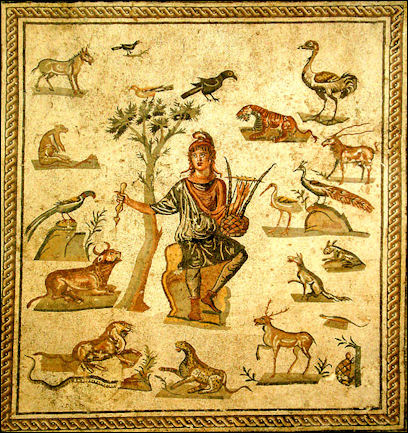
Orpheus Orpheus is a Thracian and came from the same area, near Mount Pangaeus, as Dionysus' enemy Lycurgus and Heracles' foe Diomedes and his cannibalistic horses. Said to be a son of Apollo and Calliope (The Muse from the Myrrha and Adonis story), or the son of Oeagrus, a king, he was an early follower of Dionysus, but later turned against human and blood sacrifices. He was also a noted musician and lyre-player (Apollonian traits) and a magician. It was said he could charm the birds out of the trees (similar stories were later attributed to St. Francis of Assisi, St. Anthony of Padua and the fishes) and even make trees dance.[Source: John Adams, California State University, Northridge (CSUN), “Classics 315: Greek and Roman Mythology class]
Orpheus went on the expedition with Jason and the Argonauts. On the way to Colchis, he introduced Heracles and the Argonauts to the ‘Samothracian Mysteries'. On the way back, he helped the crew to avoid the Sirens (from the Demeter and Persephone story) by covering their seductive but deadly sounds with his lyre playing.
Orpheus famously married Eurydice: (a nymph, either a Naiad or a Dryad). Shortly after her marriage she is chased through a field, where she was gathering posies, by Aristeas (the ‘Bee-Man') (Vergil, Georgics Book IV). A serpent lurking in the grass (the original snake-in-the-grass) bites her and she dies, and descends to the House of Hades, the Underworld. Orpheus descends to the House of Hades to try to rescue her, using the entrance at Tenaerum in Laconia (Sparta). Hades and Persephone agree to allow Eurydice (‘wide-judging') to go, if Orpheus can keep from looking at her until she is above ground again. He fails, and Eurydice has to return to Hades.
Orpheus returns to Thrace, where he is destroyed by native Thracian girls (of the Ciconian tribe), for one of the following reasons: a) He switched to boys exclusively after his failed marriage; 2b) He had not properly honored Dionysus, whose devotees they were (Maenads, Bacchae, Bacchantes); c) Aphrodite inspired the Ciconian women because of Calliope's judgment in favor of Demeter in the Adonis incident; or d) The Ciconian women each wanted him, and they ripped him apart (thereby making him the patron saint of rock stars).
The Muses buried Orpheus in their home in Pieria (where Apollo kept his cattle, and the royal Macedonian capital of Aegae was), except for his head. At his resting place (Libethra), near Mount Olympus, it is said that the nightingales sing more sweetly than any place else in the whole wide world. The head of Orpheus floated down the Hebrus (or is it the Haliacmon) River and out to sea. It turned up on the beach of the island of Lesbos, where an oracle of Orpheus was founded at Antissa. His lyre was placed in the sky by the gods, and became the constellation Lyra.
Orpheus and Eurydice

Orpheus and Eurydice
Orpheus was the son of Apollo and the muse Calliope. An Argonaut in his youth, he overcame the narcotic effect the Sirens by shaking his men alert so they regained their wits and rowed to safety.
Eurydice was a "nymph" who lived in the forest and hunted with the goddess Diana, feasted with Dionysus and spent time with mortals. Orpheus fell in love her. After they got married Eurydice was kidnapped by Aristaiois (one of Apollo's sons) but escaped only to be killed by a bite from a snake. Orpheus found her and vowed to go Hades, the Underworld , and bring her back.
Orpheus descended to Hades with a lyre and played a song that was so sad the cave spirits felt pity and let him pass unmolested. Charon ferried him across the River Styx and even Cerbus, the three headed dog, with hair of snakes, left him alone. Finally he met the king and queen of the Underworld and persuaded them to let him take Eurydice back to the world. But there was one catch here too: he couldn't look back to see her until they entered the light.
On the journey out of the Underworld Orpheus was filled joy. When he emerged from a cave into the light he was so overjoyed he turned around almost immediately. But he did so too soon. Eurydice had not stepped into the light yet and he lost her forever. She fell back into the cave, crying "Farewell."
Orpheus entered Hades again but was unable to win Eurydice's release. He returned to the Earth and played his lyre for the plants and animals and was ultimately torn limb from limb and beheaded by the female followers of Dionysus because he failed to join their orgies. The story ends with Orpheus lyre plying itself and his severed head singing its sad song.
Herakles (Hercules)
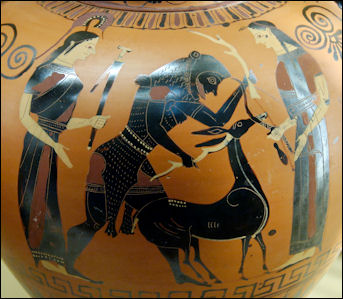
Hercules Hercules (Herakles to the Greeks and Hercules to Romans) is most popular and celebrated of the Greek heros. He was the son of the mortal Alcmene, who made love to Zeus and her husband on the same night and bore two children: Hercules son of Zeus and Iphicles, son of her husband Amphityon. Hera was angry about her husband’s indiscretion and vented her anger at Hercules.
Hercules inherited great strength from his father and began performing heroic deeds at an early age. When Hera place had two serpents placed in his cradle Hercules grabbed them and strangled them. As he was growing up he was trained in the arts of war by Centaurs and heros. When he was a young man two women sought him out. Kakia (vice) promised him an easy life of luxury and wealth if he followed her. Arete (virtue) promised him only glory from fighting evil if he followed her. Hercules followed the latter.
Marianne Bonz wrote for PBS’s Frontline: “According to Greek legend, Herakles was the son of Zeus by a mortal woman of noble lineage, whose name was Alcmene. Zeus's vengeful wife, Hera, attempted to kill the infant Herakles by placing serpents in the cradle where he and his twin brother slept. But Herakles strangled the snakes, thus saving himself and his twin. [Source: Marianne Bonz, Frontline, PBS, April 1998. Bonz was managing editor of Harvard Theological Review. She received a doctorate from Harvard Divinity School, with a dissertation on Luke-Acts as a literary challenge to the propaganda of imperial Rome.]
“In addition to semi-divine parentage and birth in difficult circumstances, another common feature of the lives of demi-gods is that they encounter ignominy or great misfortune, which they must either overcome before death or resolve through death. After he was grown and married, Herakles was struck with a deadly madness and, mistaking his own wife and children for those of a bitter enemy, he killed them. It was in atonement for this terrible crime that he performed the twelve superhuman labors that rid the world of terrifying monsters and brought new security to the world's inhabitants. Because of his superhuman strength, Herakles was the patron of athletes, and sanctuaries honoring him adorned virtually every gymnasium throughout the Greco-Roman world. But his most important role was that of powerful patron and protector of human beings and gods alike.
See Separate Article on Herakles
Jason and the Argonauts and the Golden Fleece
Jason and the Argonauts was the first nautical saga in Western Literature. Many of the events in the 3000-year-old story also took place in present-day Turkey and Georgia. The plot of the saga was this: Jason left Greece with a boat load of heroes — including Hercules, the twins Castor and Polux, and Orpheus — on a journey to Colchis (present-day Georgia) on the Black Sea to claim the Golden Fleece that came from a golden ram that long time ago carried a young Greek prince across the Black Sea to safety. Jason’s ship, the 50-oar “Argo”, contained a beam cut from the divine Dodona tree that could tell the future. Teeth of the sleepless serpent when sowed grew into armed soldiers. ["Jason's Voyage" by Tim Severin, September 1975 (⊛)]
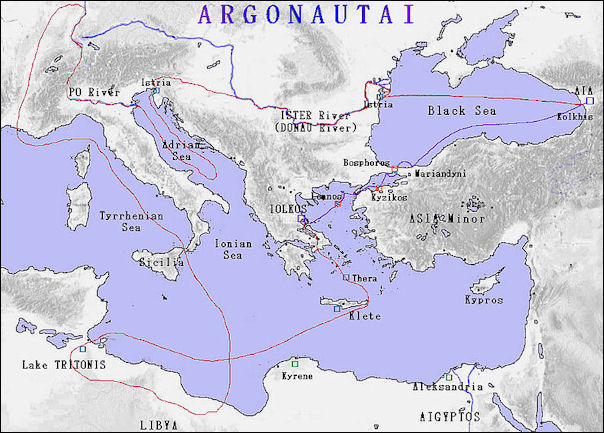
Route of Jason and the Argonauts
Claiming the Golden Fleece was regarded as an impossible task. It hung in a sacred grove guarded by an enormous serpent. If Jason managed to bring it home he could reclaim his rightful place on his father’s throne taken from him by his uncle Pelias. For thousands of years gold dust has been extracted from the rivers draining the Caucasus area by placing sheepskins on the stream bottom to trap particles. The expression the golden fleece is believed to have possibly been derived from this practice.
On his journey to Colchis Jason was challenged by a barbarian in the Aegean Sea to a boxing match to the death; he was given directions in the Sea of Marmara by a blind prophet tormented by Harpies; and the crew was beguiled by women on island without men. After barely making it through the Bosporus, the “Argo” was almost swallowed by vessel-eating rocks in the Black Sea. But finally Jason and the Argonauts made it to his destination.
After reaching Colchis, the Argonauts sailed up the River Phasis. In Colchis, Jason was given a number of tasks by King Aettes, the king of the Cochians. These including putting yokes on dangerous bulls, plowing fields where dragon teeth grew into dragons and killing the sleepless snake that guards the fleece. Jason claimed the fleece, with the help of Medea, a princess who betrayed her family, by drugging the serpent. With the fleece in hand and the princess's father ships in pursuit Jason headed back to Greece where he claimed his throne. The story's postscript unfortunately is not a happy one. Jason later married another woman and the princess from Colchis got revenge by poisoning his bride and their children.⊛
Jason and the Golden Fleece is a story of heroism, treachery, love and tragedy. It features a classic triangle of hero, dark power and female helper, a form still very much alive in Hollywood films.The Argonauts are named after their ship, the Argo, designed by Athena. Jason, son of Aeson and Polymede, of Iolcus, was captain. Tiphys, son of Hagnias, was helmsman.
See Separate Article on Jason and the Argonauts
Minotaur, Theseus and the Labyrinth
Theseus was another great Greek hero. The son of the King of Athens, he was raised in a distant land and didn’t arrive in Athens until he was a young man strong enough to lift a stone under which his father placed a sword and a pair of sandals. After becoming King of Athens he fought with Centaurs and battled Amazons
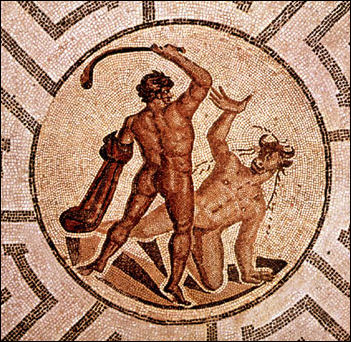
Theseus_Minotaur mosaic The story of the Minotaur and the labyrinth, according to to some, is set in Crete, presumably during the Minoan era. According to legend, King Minos was a wise leader and a just lawgiver who ruled Crete from Knossos and lived in a magnificent palace. One day the sea-god Poseidon gave him a magnificent white bull that was intended to be sacrificed in the sea god's honor. Minos greedily kept the bull instead and Poseidon got even with the king by casting a spell on his wife, which made her want to make love with the bull, which she did, producing the Minotaur. Daedalus, the Athenian architect who later tried to fly to Sicily with wings made of wax, built the Labyrinth to imprison the Minotaur.
After King Minos's son was killed in Athens the king captured Athens and secured an annual tribute of seven youths and seven virgins to be eaten by the Minotaur. One of youths offered to the Minotaur — Theseus — fell in love with King Minos's daughter. Daedalus gave Theses a ball of string so that he could find his way out of the labyrinth of he managed to kill the Minotaur. After slaying the Minotaur Theseus fled Crete with king’s daughter but as was true with heros in other Greek myths, such as Jason from the Argonauts, Theseus abandoned the girl after winning his freedom.
The Minoans believed that King Minos was the son of Europa, the daughter of King Sidon, and Zeus transformed into a bull. The association of the Minotaur myth with Knossos can be traced to Sir Arthur Evans, the British adventurer, who excavated Knossos in the 1890s. He reportedly was struck by the size of Knossos and its large number of rooms that he figured it must be the source of the labyrinth myth. Some have said he defied one of the cornerstones of archaeology by forcing evidence to fit his model rather than letting evidence speak for itself. Evans is also the source of some other dubious claims about Minoa.
See Separate Article on Minotaur, Theseus and the Labyrinth
Daedalus and Icarus
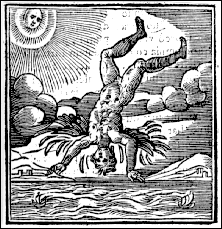
Icarus After rescuing Theseus from the Minotaur Daedalus made some wings for himself and his son Icarus to escape Crete. Daedalus became inspired to make a flying machine after watching the witch Medea take off in a fiery chariot pulled by five dragons. After observing the flight patterns of eagles, Daedalus devised wings made from eagle feathers and a special wax.
When Icarus was a child, Daedalus devised intricate toys’such life-size robots and games with 7,000 different cards — to amuse himself with. When Icarus saw the wings he wanted to try them right away but Daedalus wanted to make some flight test before taking the skies. But events in Minoa made him change his mind.
After it was discovered that Daedalus allied himself with Theseus, king of Attica, to overthrow King Minos and defeat the Minotaur, Daedalus and Icarus were forced to make a quick escape and they donned their wings. Icarus, according to legend, flew too high and the wax on his wings melted but Daedalus made it to Italy.
Daedalus is considered the "inventor" of the art of sculpture. He created the art on the island of Sicily after he escaped the Labyrinth with his wax and feather wings. The legend is probably based on a real-life Daedalus who lived in Crete in the 7th century B.C. and was known for his craftsmanship. [Source: "The Creators" by Daniel Boorstin,μ]
Recreating Icarus's Flight
In the summer of 1988 a Greek cyclist and a team of engineers and students from the Massachusetts Institute of Technology attempted to recreate the flight of Daedalus in a human powered aircraft. If you recall Daedalus made it to Italy. Italy was too far away for the MIT team so for their attempt they chose Santorini which is 27 miles away.¶
“Daedalus” , not surprisingly, was the name they chose for their human powered aircraft. The frame of the aircraft was made from super light, super stiff graphite epoxy that was layered and shaped and baked in an oven. The hollow 112 foot main wing tube was the thickness of a dime. The wing itself was made of polystyrene foam ribs covered the ultra thin Mylar plastics. Holding at all together was Kevlar yarn and a few metal screws. Pieces of metal were drilled out to conserve weight and even the glue was weighed to produce the 68.5 pounds craft.
The 11 foot propeller turned 105 revolutions per minute to reach a speed of 21 miles per hour or "Mach .03" one MIT student observed. To fly the craft the 27 mile distance from Crete to Santorini would take the same amount of energy as pedaling a racing bike 23 miles an hour for six hours. The man chosen to fly the craft was Kanellos Kanellopoulos, 14 time Greek cycling champing. He trained by riding 60 to 100 miles a day and nourished himself on 7000 calories day. On the day of the flight he wore cycling shorts sliced up with dozens of small holes to "show the extreme measures taken to conserve energy."
After waiting around for weeks for the wind to die down enough to make the flight possible, “ Daedalus “ took off at 7:03am on April 23, 1988. As Kanellopoulos soared at a speed of 14 knots, 50 feet above the water, he exclaimed "It better than perfect!" At 8:29am he had flown 23 miles, a new distance record, and at 9:52 he broke the record for time aloft...but he didn't quite make it to Santorini. Just as he neared the black sand shore of the island a gust of wind hit the aircraft splintering the graphite tail boom and braking the right wing spar. Kanellos freed himself from his pedals and escaped from the craft when it gently hit the water. He came up out of the water with a smile. “ Daedulus” was in the air for 3 hours, 54 minutes and 59 second and although it landed 50 feet short of it destination everyone felt it had triumphed.
Perseus and the Medusa
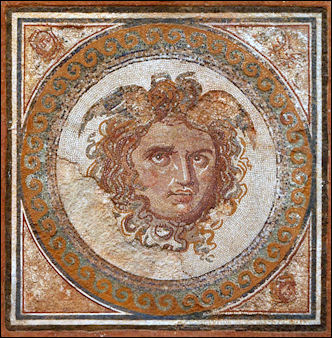
Medusa Perseus was the son of Zeus and Danae, the beautiful daughter of the evil king of Argos. The king had banished Danae and Perseus from his kingdom because of an oracle that predicted his son would kill him. Danae and Perseus ended up on an island with a king who desired Danae but figured the only way to get her was to get rid of Perseus by sending him on an impossible task: to bring back the head of the Medusa.
The Medusa was one of the three Gorgons, horrid sisters with bat-like wings, fierce claws and poisonous snakes hissing from their heads. One look from the sisters could turn a man to stone. The king thought that Perseus would probably die in his effort. But Theseus had the gods on his side. Athena gave him a hughly polished shield. Hermes gave him a magic sword and special winged sandals. Pluto gave him a cape of darkness, which made him invisible.
On his journey to the land of the Gorgons Perseus encountered the three Gray Sisters, who had only one eye between them. He stole their eye and refused to give it back until the sisters told him where to find the Gorgons. With their directions Theseus came upon the Gorgons while they were sleeping. Putting on the cloak of darkness he approached them. Using the polished shield as a mirror, so he wouldn’t have to look at them directly Theseus cut off the head of the Medusa with the sword and escaped with the help of the winged sandals. Later with his magic sword Perseus killed a sea monster and saved the beautiful Andromeda. They fell in love. At the wedding an old boyfriend tried to claim Andromeda. Perseus turned him stone by holding up the head of the Medusa.
Hero, Leander, Byron and Pandora
Hero was a priestess of Aphrodite. She lived on the European side of the Hellespont (the Dardanelles) a 38-mile-long strait between the Aegean Sea and the Sea of Marmara that is less than a mile across in some places. At a festival she met Leander, who lived on the Asian side of the strait. They fell in love. Every night he would swim across the Hellespont to see her, guided by a torch she held out for him. One night a terrible storm blew in. The torch blew out and Leander, not able to see his way, got lost and drowned. Hero found his body on the shore. Unable to bear the grief, the broken-hearted Hero threw herself into the sea and drowned as well.

Hero and Leander
On May 3, 1810, the famous English poet Lord Byron, who lived briefly next to the Dardanelles, duplicated Leander’s swim across the Hellespont. The distance is only a mile but the current was so strong that Byron doubted "whether Leander's conjugal power must not have been exhausted in his passage to Paradise." He later wrote of the experience, "I plume myself on this achievement more than I could possibly for any kind of glory, political, poetical, rhetorical."
Pandora was the first woman on earth. She was created by Zeus, angered that Prometheus had given mankind fire, to bring pain and suffering to men. Hephaestus molded her from clay. Athena gave her femininity. Hermes gave her the powers of persuasion. Aphrodite gave her beauty. Pandora means “all gifted.”
Before arriving on earth Pandora was given a box (or a jar) by Zeus. On earth she married a king who told her not open the box. Unable to hold back her temptation, Pandora, disobeyed her orders, and opened a box. It unleashed all of the ills of the world. Only hope was left inside. Some scholars have argued that Pandora's "box" was her body.
Satyrs, Centaurs and Other Mythical Figures
Centaurs were lusty half-man-half-horse creatures created from a union between the bloody horse Penis and the Earth Mother. The lived mostly in the forest, consumed large amounts of wine and roamed the Earth looking for young brides to carry off and rape. Once a king made the mistake of inviting a bunch of centaurs to the wedding of his daughter. They got drunk and rowdy and tried to carry away the bride When some of the kings men tried to stop them a fierce battle broke out. Not all centaur were bad. One was tutored by Apollo and in turn tutored Apollo’s children. For his efforts he was awarded with immortality and became the constellation Sagittarius.
Satyrs (known as fauns to the Romans) were horned, goat-legged spirits of forests and hills. They were evil creatures and were greatly feared by travelers.
Damocles was a real person. He served in the court of the 4th century king of Syracuse. Once he offended the king. To get even the kinghosted a huge banquet. Damocles enjoyed himself until he looked up and saw a sword hanging over his head suspended by a single horse hair.
The sirens were the half-women, half-woman creatures that lured sailors to death with their song. Tityus, a giant found guilty of attempted rape, had his liver devoured by vultures everyday while chained to rocks only to have it grow back at night os the process could be repeated. . Arion was thrown overboard from a ship and rescued by dolphins. Philocetes, an archer of Greek mythology, was abandoned on an island because of the repulsive wound that would not heal.
Pegasus, Griffins and Chimera
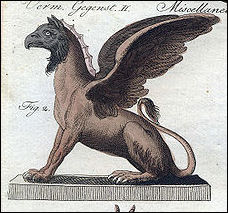
griffin The Chimera was a fire-breathing monster with the a lion’s head, a goat’s body and a serpent’s tail. According to legend, it was slain in by the hero Bellerophon, mounted on Pegasus. Pegasus was a winged horse that sprang from the body of Medusa. Once Bellerophon wanted to be carried heaven. Pegasus obliged. On the way he was stung by an insect sent by the gods. Bellerophon was thrown and landed on earth, alive but lamed and blind. Pegasus was placed among the stars and became a constellation.
Griffins have the head and body of a lion, wings and beak of an eagle and the tail of a serpent or lion. Stories about griffons originated with Scythian horsemen in Central Asia. They described griffons as “lions but with beak and wings of an eagle” and said they nested on the ground over deposits of gold. Many of images of winged monsters and fighting animals reached Greece by way of ivory carvings and metal work from Phoenician and Syria.
The basilisk was originally a snake that was so horrible just looking at it killed a man. Pliny the Elder described it as small golden snake with a golden crown. In the Middle Age became a snake with the head of rooter or a human.
According to Greek legend, spiders were created when the a seamstress named Arachne challenged the goddess Athena to a contest. Later the weaver was ashamed of her impunity and hung herself. Athena felt sorry for her and brought her back to life as a spider and her noose was made into a web. Her name was also given to the scientists who study spiders (arachnologists), the fear of them (arachanaphobia) and the class of animals (Arachnida).
Ancient Greek Mythical Beasts and Evidence of Their Existence
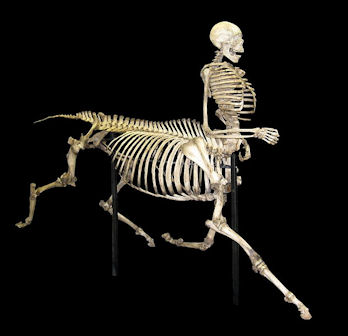
Centaur skeleton Beasts found in Greek mythology include centaurs, satyrs, griffons and dragons. There are number of giants and semi-human, larger-than-life beings. Among them are Atlas, the Cyclops and the Titans. Arguably the greatest of them all was the Pelops. Described as having shoulder blades made of ivory, he is said to have created the Olympic games to thank the gods after winning a rigged chariot race. He ruled over Greece’s southern peninsula — the Peloponnese, which means “Pelops island.”
Adrienne Mayor, an independent folklorist, believes that some of the beasts and giants in Greek mythology may have been based on fossils of dinosaurs and prehistoric mammals found in ancient Greece and other places familiar to the Greeks.
Mayor bases her theory on: 1) the fact that the locations of Greek myths are often rich in fossils; 2) a head of an unusual monster depicted on Corinthian vase that looks just like a skull of an extinct giraffe, whose bones are commonly found on Greek islands and Asia Minor; 3) mastodon bones found on the island of Samos, where giants are said to have lived, can be arranged to look like the bones of giants; 4) skeletons of “Protoceretops” (dinosaurs) found in Central Asia match descriptions of griffons, who first described by Scythian horsemen who lived there and passed on to the Greeks.
A temple in Olympia was said to have a relic of the mighty giant — a massive shoulder blade. During the Trojan War it was reportedly shipped to the walls of Troy to bring good luck. Greek chroniclers, including Herodotus, described seeing the remains of giants. Mayor believes the Greeks were not making this up and what they were describing were bones of prehistoric animals such as mastodon or mammoth, whose skeletons when placed upright could very easily pass as the skeleton of a giant. She told National Geographic, “Since the 19th century, modern paleontologists have discovered rich bone beds of giant extinct mammals in the same places the ancient Greeks reported finding bones of heroes and giants.” The Aztec had similar ideas about the fossilized mammoth and mastodon bones they found.
Mayor also said, the Greeks “found fossil ivory tusks from extinct mammoths in the ground and assumed the ivory was produced by the Earth, like gems and minerals. In fact, the ancient Greeks word for ivory, “elephas”, was the name they gave to elephants once they did encounter them.” This first encounter probably occurred in the 4th century B.C. When Alexander the Great’s army faced a force of Persian war elephants.
Image Sources: Wikimedia Commons, The Louvre, The British Museum
Text Sources: Internet Ancient History Sourcebook: Greece sourcebooks.fordham.edu ; Internet Ancient History Sourcebook: Hellenistic World sourcebooks.fordham.edu ; BBC Ancient Greeks bbc.co.uk/history/ ; Canadian Museum of History historymuseum.ca ; Perseus Project - Tufts University; perseus.tufts.edu ; MIT, Online Library of Liberty, oll.libertyfund.org ; Gutenberg.org gutenberg.org Metropolitan Museum of Art, National Geographic, Smithsonian magazine, New York Times, Washington Post, Los Angeles Times, Live Science, Discover magazine, Times of London, Natural History magazine, Archaeology magazine, The New Yorker, Encyclopædia Britannica, "The Discoverers" [∞] and "The Creators" [μ]" by Daniel Boorstin. "Greek and Roman Life" by Ian Jenkins from the British Museum.Time, Newsweek, Wikipedia, Reuters, Associated Press, The Guardian, AFP, Lonely Planet Guides, “World Religions” edited by Geoffrey Parrinder (Facts on File Publications, New York); “History of Warfare” by John Keegan (Vintage Books); “History of Art” by H.W. Janson Prentice Hall, Englewood Cliffs, N.J.), Compton’s Encyclopedia and various books and other publications.
Last updated September 2018
